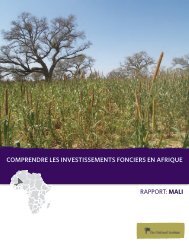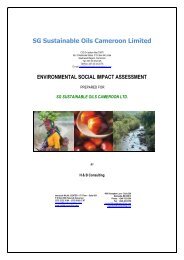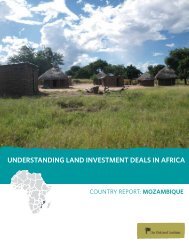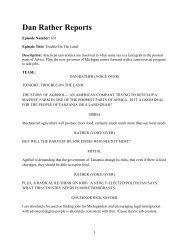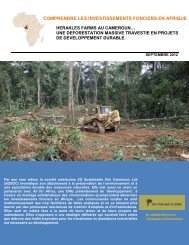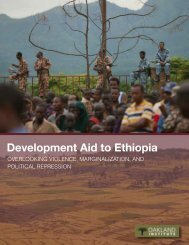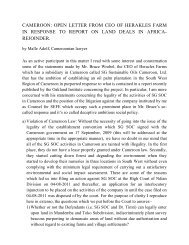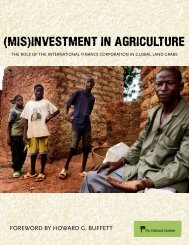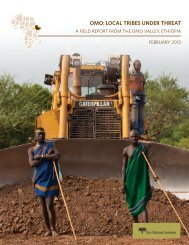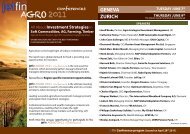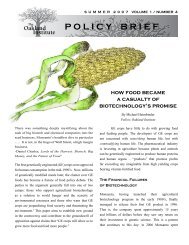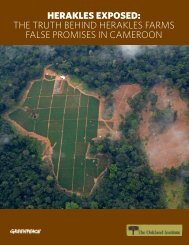Zambia - Oakland Institute
Zambia - Oakland Institute
Zambia - Oakland Institute
You also want an ePaper? Increase the reach of your titles
YUMPU automatically turns print PDFs into web optimized ePapers that Google loves.
FIGURE 1: COPPER PRICE HISTORY<br />
Source: http://upload.wikimedia.org/wikipedia/en/thumb/7/7d/Copper_Price_History_USD.png/800px-Copper_Price_History_USD.png<br />
Economic<br />
The last few years have seen steady growth with real<br />
GDP growing at 6-8 percent between 2005 and 2010.<br />
At the same time there is concern that there are great<br />
inequalities in terms of the distribution of <strong>Zambia</strong>’s<br />
GDP, and that despite this steady growth, poverty<br />
remains a serious problem.<br />
The performance of <strong>Zambia</strong>’s GDP is directly<br />
proportional to copper production/prices. Development<br />
assistance also makes a large contribution to<br />
<strong>Zambia</strong>’s economy – with USD 1.27 billion in 2009. 10<br />
There is a recognition that <strong>Zambia</strong> needs to diversify<br />
its economy and not be so reliant on favorable copper<br />
prices to sustain growth. As a result, greater economic<br />
diversification has been a cornerstone of <strong>Zambia</strong>’s<br />
macroeconomic planning (currently focused on<br />
strengthening agriculture, tourism, manufacturing,<br />
and hydropower sectors). At the same time, there are<br />
numerous calls for <strong>Zambia</strong> to benefit more favorably<br />
from the mining industry. As a result of the WB/IMF<br />
Structural Adjustment Programmes (SAP) of the<br />
early 1990s, taxes and royalties from mining activities<br />
contribute little to government coffers and government<br />
revenues from the mining industry are far lower than<br />
many other SSA countries. The SAPs have also ensured<br />
that very little of the profits of the mining industry stay<br />
in the country, with limited multiplier effects from<br />
<strong>Zambia</strong>’s prime natural resource.<br />
TRADE BALANCE<br />
<strong>Zambia</strong>’s main exports are copper (64 percent of total<br />
export value in 2008) and cobalt, although agricultural<br />
exports and electricity are becoming bigger earners. 11<br />
<strong>Zambia</strong> is an importer of crude oil and fertilizer.<br />
Processed foods are also routinely imported (often<br />
from South Africa). As of 2008, <strong>Zambia</strong>’s main import<br />
partner was South Africa at 52.8 percent of imports,<br />
with UAE at 8.9 percent, and China at 6.9 percent. 12<br />
The need to import crude oil and fertilizer is seen as<br />
a constraint to large-scale agricultural development<br />
in the country and puts <strong>Zambia</strong> at a comparative<br />
disadvantage relative to its neighbors, many of whom,<br />
have easier and cheaper access to these inputs.<br />
FOREIGN DEBT<br />
Historically, <strong>Zambia</strong>’s economy has often been<br />
crippled under the burden of heavy debt repayments<br />
to international lenders. This cycle began in the 1970s<br />
when the socialist <strong>Zambia</strong>n government borrowed<br />
heavily to offset the drop in copper prices (and thus<br />
revenues) and never quite recovered. However, <strong>Zambia</strong><br />
has benefited from debt service relief under the Heavily<br />
Indebted Poor Countries initiative (HIPC) – nearly USD<br />
6 billion in debt relief. In July 2005, all outstanding<br />
debts were relieved, and a huge economic burden for<br />
<strong>Zambia</strong> was removed.<br />
The <strong>Oakland</strong> <strong>Institute</strong> UNDERSTANDING LAND INVESTMENT DEALS IN AFRICA: ZAMBIA | 7



